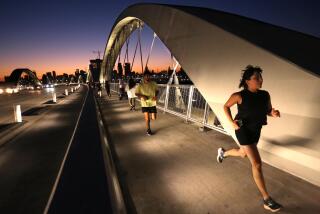Touring the manly realm of London’s Travellers Club
- Share via
London — Membership in the Royal Geographical Society has its privileges.
The 174-year-old organization, sponsor of groundbreaking expeditions and arbiter of geographical debates, is in a distinguished Victorian edifice overlooking London’s Kensington Gardens. Its new exhibition gallery and reading room are open to visitors, but you must be a member to get in the historic main building, have lunch in the tea room or attend most RGS events.
I recently joined (about $180 a year, including a subscription to the society’s monthly magazine) just so I could participate in the geographic society’s tour of another equally renowned but far more exclusive London institution, the Travellers Club. That club, on Pall Mall in the dignified heart of London, was established in 1819 to give people who traveled widely a place to meet and entertain guests, and it has become the quintessential English gentleman’s club.
Why, you might ask, didn’t I just join the Travellers Club? Easy. Only men are allowed, most of them eminent and well connected. The club’s 1,200 members are diplomats, civil servants, writers, businessmen, barristers, soldiers and clergymen from all over the world.
In the past, these included Charles Maurice de Talleyrand, the 19th century French ambassador to England; five prime ministers; author and desert traveler Wilfred Thesiger; and Catholic theologian Alfred Gilbey, who virtually lived at the club for 25 years. Meanwhile, dukes, earls and marquises were denied.
The building is a historic landmark, sandwiched between the “stately Athenaeum and the grandiose Reform [Club], as if Mozart were sitting between Bach and Beethoven,” as Graham Binns put it in “Travellers’ Tales,” a 1999 compendium of club members’ adventures.
The clubhouse was designed with classic simplicity by Charles Barry, chief architect of the Houses of Parliament, and resembles the Florentine palazzos that 19th century members saw on the Italy leg of the Grand Tour.
Nearby are the World War II headquarters of Gens. Dwight D. Eisenhower and Charles de Gaulle, the custom tailors and haberdashers on Jermyn Street, Christopher Wren’s St. James’s Church and beautiful Green Park.
The tour started in the outer morning room, where the RGS group sipped coffee on deep sofas and chairs before meeting our guides, club members Thomas Sutherland, Henry Brownrigg and Jann Schwartz. On the walls were pictures of Venice, Italy, and the club’s prize portrait of Emma Hamilton -- wife of diplomat William Hamilton and mistress of Horatio Nelson -- done by 18th century English painter George Romney.
We moved through the foyer to the smoking room, with its backgammon set, humidor and squeaky leather-upholstered chairs whose semicircular armrests help keep inebriated members upright, Brownrigg said.
From there we mounted the grand staircase, lined by a marble plaque commemorating club members who served in the Great War, and headed for the misleadingly named coffee room, which serves meals but never coffee. It has a high vaulted ceiling, three huge crystal chandeliers, a portrait of George Macartney, England’s first ambassador to China, and a large oval table in the middle for socializing, surrounded by smaller tables for those who want to dine in solitude.
The food and wine at private gentlemen’s clubs used to be notoriously bad, but it’s quite good here, Brownrigg said, especially the wine.
Amontillado sherry was offered when we reached the library, the most magnificent room in the club. The library is banded near the ceiling by a famous Greek frieze discovered in 1811 in the Temple of Apollo at Bassae by founding member C.R. Cockerell. A head of Hermes, the mythological god who sweeps travelers’ paths clean, is above the fireplace, and by the window is an unprepossessing armchair favored by the Queen Mother, who held Christmas parties for her staff at the club.
A high shelf of leather-bound tomes hides a false door leading to a butler’s pantry. But all the rest of the books are real, including last year’s “Captain Scott,” by club member Ranulph Fiennes, and “Betel Cutters: From the Samuel Eilenberg Collection,” by Brownrigg, a collector and dealer in Asian and Islamic art who told me that his is the best, the worst and the only volume on the subject.
I also found several copies of “Travellers’ Tales” and bought one from the porter as I left. Back at my hotel, I read about the experiences of club members on the road. My favorite entries were on Michael Tomkinson’s frustrated linguistic expedition to Socotra, an island off Yemen, where almost no one would talk to him, and Christopher Brasher’s meeting in Yosemite with a bear that turned out to be a marmot.
I could imagine the contentment with which such men returned to their island of calm, comfort and familiarity on Pall Mall. Parliament will outlaw fox hunting long before the club accepts women. But for an afternoon, at least, I was an honored member.
Susan Spano also writes “Postcards From Paris,” which can be read at www.latimes.com/susanspano.
More to Read
Sign up for The Wild
We’ll help you find the best places to hike, bike and run, as well as the perfect silent spots for meditation and yoga.
You may occasionally receive promotional content from the Los Angeles Times.






